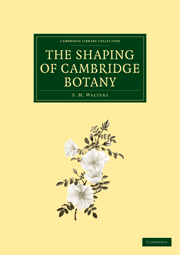 The Shaping of Cambridge Botany
The Shaping of Cambridge Botany Book contents
- Frontmatter
- Contents
- Dedication
- List of illustrations
- To Lorna
- Preface and acknowledgements
- 1 Introduction: botany, medicine and horticulture
- 2 Ray and the herborising tradition
- 3 Bradley and the horticultural tradition
- 4 The Martyns and the Linnaean tradition
- 5 Henslow and the rise of natural science
- 6 Babington, Vines and Lynch: the fragmentation of botany
- 7 The New Botany School: Marshall Ward and his successors
- 8 Whole-plant botany and the modern Botanic Garden
- Bibliography
- Index
Preface and acknowledgements
Published online by Cambridge University Press: 05 July 2011
- Frontmatter
- Contents
- Dedication
- List of illustrations
- To Lorna
- Preface and acknowledgements
- 1 Introduction: botany, medicine and horticulture
- 2 Ray and the herborising tradition
- 3 Bradley and the horticultural tradition
- 4 The Martyns and the Linnaean tradition
- 5 Henslow and the rise of natural science
- 6 Babington, Vines and Lynch: the fragmentation of botany
- 7 The New Botany School: Marshall Ward and his successors
- 8 Whole-plant botany and the modern Botanic Garden
- Bibliography
- Index
Summary
An institutional anniversary provides the occasion to stand back from the transient pre-occupations of administration, teaching and research, and look at the tradition in which the particular institution operates. In my own case, several factors have coincided to make the process especially congenial. The first, and most important, is very personal, and concerns my attitude to history. Twenty years ago, the suggestion that I should write a book on the history of the Botanic Garden, or of Cambridge botany, would have worried and even depressed me: now I find the opportunity richly rewarding. I can only report this change of heart without comment.
A second factor is the product of my career as Curator of the Herbarium and Lecturer in the Botany School, from which I was appointed in 1973 as Director of the Garden. This translation from a professional career in scientific botany in the main University Department to my present post enables me to appreciate the separate and combined elements in two interestingly different traditions, and stimulates me to ask how the differences came about. To some extent, this book is a product of such questioning.
The third of the factors encouraging me to write this little book concerns the nature and size of the University Botanic Garden itself. An institution occupying under 40 acres and employing fewer than 40 people is a comprehensible whole, in which it is possible to feel personal links and loyalties and to understand the nature and strength of tradition.
- Type
- Chapter
- Information
- The Shaping of Cambridge BotanyA Short History of Whole-Plant Botany in Cambridge from the Time of Ray into the Present Century, pp. xi - xviPublisher: Cambridge University PressPrint publication year: 1981
